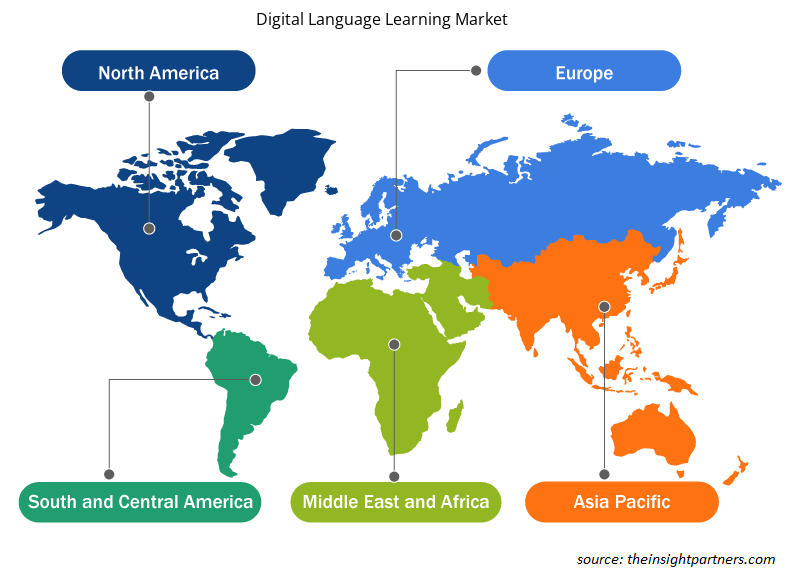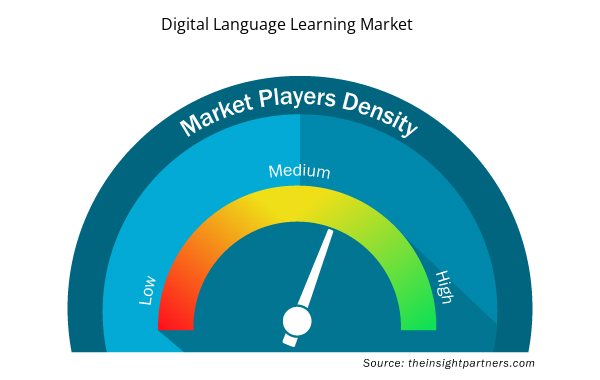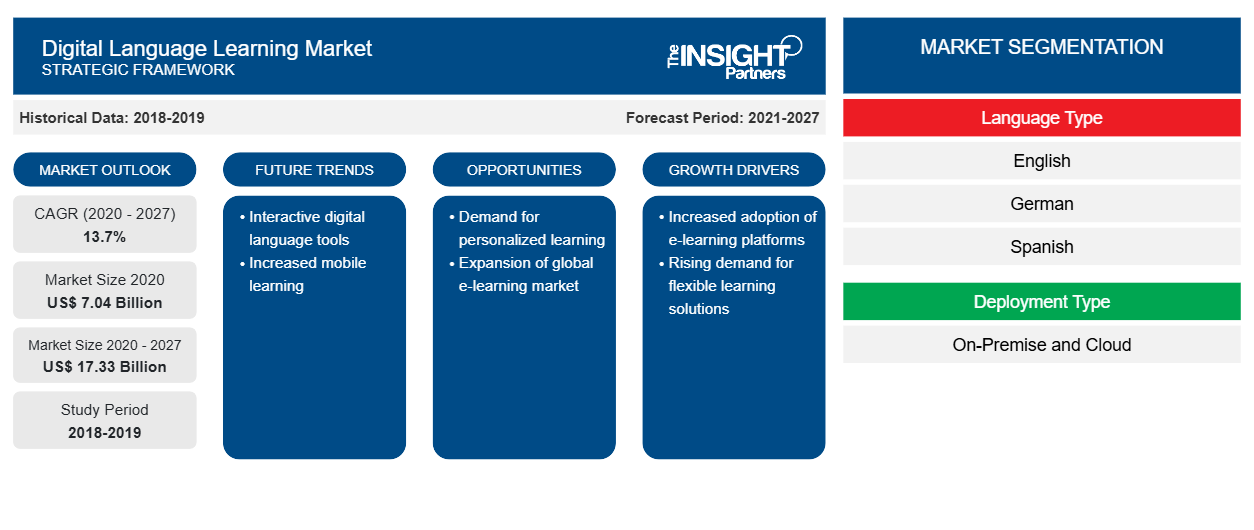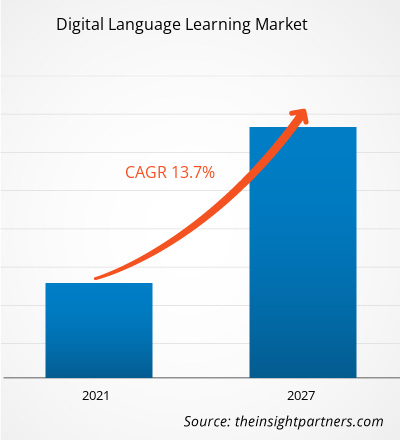Se espera que el mercado de aprendizaje de idiomas digitales crezca de US$ 7038,2 millones en 2020 a US$ 17 333,4 millones en 2027; se estima que crecerá a una CAGR del 13,7% entre 2020 y 2027.
Las iniciativas de varios gobiernos para implementar programas de aprendizaje del idioma inglés se atribuyen al crecimiento del mercado. El sector educativo global se está transformando exponencialmente gracias a varias iniciativas emprendidas por gobiernos y organizaciones privadas para ofrecer un rendimiento mejorado digitalmente. Los gobiernos de varios países, como China, Australia, Brasil y los Emiratos Árabes Unidos, han iniciado programas de educación digital en los últimos años, lo que ha ayudado a estos países a impulsar sus sistemas de educación en inglés. Por ejemplo, la Revolución de la Educación Digital (DER) del gobierno australiano, que se inició hace una década, ha permitido que varias escuelas y universidades aprovechen la educación digital. De manera similar, el gobierno chino también ha iniciado varias políticas para impulsar la educación digital con un enfoque principal en el aprendizaje del idioma inglés, lo que ha impulsado el aumento en el número de empresas que ofrecen soluciones de aprendizaje digital a los estudiantes chinos. 51Talk es una de las instituciones de aprendizaje digital del idioma inglés más destacadas en China; 17Zuoye es otra plataforma digital para estudiantes, maestros y padres chinos, que ofrece tareas en línea en forma de ejercicios y tareas, lo que permite a los usuarios finales mejorar sus capacidades. Actualmente, la India está avanzando para crear un espacio de mercado sustancial para la educación digital. El gobierno indio ha emprendido varias iniciativas para popularizar las tecnologías de digitalización en el sector educativo. SWAYAM es la plataforma de aprendizaje digital más destacada y la iniciativa emprendida por el gobierno indio, que ayuda a los estudiantes a optar por cursos en línea, que cubren todas las materias de la educación superior. Las universidades internacionales también pueden ofrecer sus respectivos cursos y exámenes a través de la plataforma SWAYAM, que facilita que los estudiantes aprendan y opten por los exámenes de universidades internacionales. Este factor mejora el aprendizaje del inglés, la expresión oral y la escritura de los estudiantes. La biblioteca digital nacional es otra iniciativa implementada por el gobierno indio con la visión de ofrecer una fuente virtual de recursos de aprendizaje, desde una instalación de ventanilla única. Esta iniciativa está ganando prominencia gradualmente y se espera que impulse el mercado de aprendizaje digital del idioma inglés en la India para que crezca en los próximos años, contribuyendo así al crecimiento del mercado global de aprendizaje digital de idiomas.
Personalice este informe según sus necesidades
Obtendrá personalización en cualquier informe, sin cargo, incluidas partes de este informe o análisis a nivel de país, paquete de datos de Excel, así como también grandes ofertas y descuentos para empresas emergentes y universidades.
- Obtenga las principales tendencias clave del mercado de este informe.Esta muestra GRATUITA incluirá análisis de datos, desde tendencias del mercado hasta estimaciones y pronósticos.
Impacto de la pandemia de COVID-19 en el mercado del aprendizaje digital de idiomas
El reciente brote de la pandemia ha provocado una considerable disrupción positiva en el sector educativo existente a nivel mundial durante los últimos meses. Además, la disrupción en las instituciones educativas convencionales y las técnicas de aprendizaje en el aula han provocado un aumento en la adopción de soluciones de aprendizaje en línea y digitales sólidas y eficientes que se prevé que seguirán impulsando el crecimiento del mercado más allá de la pandemia en los próximos años. Por ejemplo, la UNESCO, junto con varios representantes destacados de empresas tecnológicas y la UIT (Unión Internacional de Telecomunicaciones), colaboraron para enfatizar la importancia económica de la adopción de tecnologías digitales en el aprendizaje para permitir capacidades de aprendizaje rápido entre la audiencia más amplia sin una inversión considerable en infraestructuras físicas entre las economías emergentes.
Mientras que, en una encuesta separada realizada por la Universidad de Cambridge, más de 1200 encuestados identificaron una mayor propensión a continuar con las tecnologías de aprendizaje digital entre el 60% de los candidatos de la encuesta en los próximos años. Por lo tanto, el reciente brote ha facilitado un aumento en la adopción de las tecnologías de aprendizaje digital y, posteriormente, ha impactado positivamente en el crecimiento del mercado en los últimos meses.
Perspectivas de mercado: mercado del aprendizaje digital de idiomas
Aprovechar tecnologías avanzadas y simplificadas para atraer a los estudiantes hacia la educación digital
En los países desarrollados, como Estados Unidos y el Reino Unido, el sistema de educación digital ha ganado una inmensa popularidad, ya que los estudiantes de las escuelas, universidades y otras instituciones conocen perfectamente las tecnologías. Sin embargo, en los países de Asia Pacífico y el Sur de Asia, los estudiantes carecen de la conciencia del aprendizaje impulsado por la tecnología. Varias escuelas, universidades e instituciones de formación están implementando tecnologías digitales en sus clases. Mientras que los desarrolladores de plataformas educativas digitales están constantemente actualizando sus tecnologías para ofrecer soluciones sólidas, los adoptantes en Asia Pacífico están continuamente actualizando su infraestructura tecnológica. Se espera que las innovadoras aplicaciones educativas basadas en la nube, sitios web y otros servicios creen un mercado significativo para la educación digital, incluidas las soluciones de aprendizaje de idiomas digitales.
Perspectivas basadas en tipos de lenguaje
Según el tipo de idioma, el mercado de aprendizaje de idiomas digitales se segmenta en inglés, mandarín, español, alemán y otros. El segmento de inglés tuvo la mayor participación de mercado en 2019.
Perspectivas regionales del mercado del aprendizaje digital de idiomas
Los analistas de Insight Partners explicaron en detalle las tendencias y los factores regionales que influyen en el mercado de aprendizaje digital de idiomas durante el período de pronóstico. Esta sección también analiza los segmentos y la geografía del mercado de aprendizaje digital de idiomas en América del Norte, Europa, Asia Pacífico, Oriente Medio y África, y América del Sur y Central.

- Obtenga datos regionales específicos para el mercado de aprendizaje digital de idiomas
Alcance del informe sobre el mercado del aprendizaje digital de idiomas
| Atributo del informe | Detalles |
|---|---|
| Tamaño del mercado en 2020 | US$ 7.04 mil millones |
| Tamaño del mercado en 2027 | US$ 17.33 mil millones |
| Tasa de crecimiento anual compuesta (CAGR) global (2020-2027) | 13,7% |
| Datos históricos | 2018-2019 |
| Período de pronóstico | 2021-2027 |
| Segmentos cubiertos | Por tipo de idioma
|
| Regiones y países cubiertos | América del norte
|
| Líderes del mercado y perfiles de empresas clave |
|
Densidad de actores del mercado: comprensión de su impacto en la dinámica empresarial
El mercado del aprendizaje digital de idiomas está creciendo rápidamente, impulsado por la creciente demanda de los usuarios finales debido a factores como la evolución de las preferencias de los consumidores, los avances tecnológicos y una mayor conciencia de los beneficios del producto. A medida que aumenta la demanda, las empresas amplían sus ofertas, innovan para satisfacer las necesidades de los consumidores y aprovechan las tendencias emergentes, lo que impulsa aún más el crecimiento del mercado.
La densidad de actores del mercado se refiere a la distribución de las empresas o firmas que operan dentro de un mercado o industria en particular. Indica cuántos competidores (actores del mercado) están presentes en un espacio de mercado determinado en relación con su tamaño o valor total de mercado.
Las principales empresas que operan en el mercado del aprendizaje digital de idiomas son:
- Babbel
- Busuu Ltd
- Fluenz
- Lingoda GmbH
- Lenguaje vivo (Penguin Random House, LLC)
Descargo de responsabilidad : Las empresas enumeradas anteriormente no están clasificadas en ningún orden particular.

- Obtenga una descripción general de los principales actores clave del mercado de aprendizaje de idiomas digitales
Los actores que operan en el mercado del aprendizaje de idiomas digitales se centran principalmente en el desarrollo de productos avanzados y eficientes.
- En 2019, Fluenz anunció la expansión de su Programa de Inmersión de Lujo en Español a Barcelona, España, en la primavera de 2020. Los usuarios podrán unirse al programa durante seis días para aprender idiomas.
- En 2018, Preply, Inc. anunció sus planes de abrir una nueva oficina en Barcelona a principios de 2019. La expansión fue el resultado de una financiación de 4 millones de dólares en julio. La empresa también planea ampliar su presencia en los mercados alemán, británico, estadounidense y latinoamericano.
El mercado del aprendizaje digital de idiomas se ha segmentado de la siguiente manera:
Mercado mundial de aprendizaje digital de idiomas: por tipo de idioma
- Inglés
- Alemán
- Español
- mandarín
- Otros
Mercado mundial de aprendizaje digital de idiomas: por tipo de implementación
- En las instalaciones
- Nube
Mercado mundial de aprendizaje digital de idiomas: por tipo de negocio
- De empresa a empresa
- De empresa a cliente
Mercado mundial de aprendizaje digital de idiomas: por usuario final
- Académico
- No académico
Mercado mundial de aprendizaje digital de idiomas, por geografía
- América del norte
- A NOSOTROS
- Canadá
- México
- Europa
- Francia
- Alemania
- Italia
- Rusia
- Reino Unido
- Resto de Europa
- Asia Pacífico (APAC)
- Japón
- Porcelana
- Australia
- India
- Corea del Sur
- Resto de APAC
- Oriente Medio y África (MEA)
- Arabia Saudita
- Emiratos Árabes Unidos
- Sudáfrica
- Resto de MEA
- América del Sur (SAM)
- Brasil
- Argentina
- Resto de SAM
Mercado de aprendizaje digital de idiomas: perfiles de empresas
- Babbel
- Busuu, Limitada.
- Fluenz
- Lingoda GmbH
- Lenguaje vivo (Penguin Random House, LLC)
- Sociedad Anónima Pearson
- Preply, Inc.
- Piedra de Rosetta, Inc.
- Verbling, Inc.
- Yabla, Inc.
- Análisis histórico (2 años), año base, pronóstico (7 años) con CAGR
- Análisis PEST y FODA
- Tamaño del mercado Valor/volumen: global, regional, nacional
- Industria y panorama competitivo
- Conjunto de datos de Excel


- Fish Protein Hydrolysate Market
- Sandwich Panel Market
- Oxy-fuel Combustion Technology Market
- Joint Pain Injection Market
- Hair Extensions Market
- Ceramic Injection Molding Market
- Health Economics and Outcome Research (HEOR) Services Market
- Bathroom Vanities Market
- Tortilla Market
- Virtual Production Market

Report Coverage
Revenue forecast, Company Analysis, Industry landscape, Growth factors, and Trends

Segment Covered
This text is related
to segments covered.

Regional Scope
North America, Europe, Asia Pacific, Middle East & Africa, South & Central America

Country Scope
This text is related
to country scope.
Preguntas frecuentes
APAC region led digital language learning market. APAC comprises countries with developed educational sectors, including China, Australia, India, Singapore, and South Korea. These countries are leveraging every possible method and model to enhance English proficiency with an aim to increase the number of English speaking individuals. According to EF Education First English Proficiency Test, Asian countries hold the second position, after Europe, among the non-native English speaking countries. Over the years, countries in APAC have been investing significantly in promoting English language learning and also has lucrative opportunities for English learning.
Increasing number of Asian students migrating to western countries is the major factor driving the growth of the market. Digital English language learning is witnessing the major demand from the both academic and non-academic sectors in Asian countries. The currently increasing trend among Asian students to enroll themselves in universities in the western countries for higher education is creating a significant demand for language learning courses. Majority of the candidates from Asian countries, especially from India and China, enroll themselves for Test of English as a Foreign Language (TOEFL), International English Language Testing System (IELTS), Graduate Record Examination (GRE), Test of English for International Communication (TOEIC), and other language-based courses and certifications. TOEFL and IELTS are the tests conducted to assess a non-native candidate’s English fluency level, including proper English speaking and writing skills. This factor compels the enrolling candidates to opt for English Language Training (ELT) institutes. The burgeoning demand for these competitive exams has led to the establishment of various ELT institutions across these countries, which in turn has opened up avenues for different English learning methods.
English is the most preferred language in terms of business perspectives across the globe, and close to 30 nations worldwide have it as their primary language of communication. More than 20% of the global population speaks this language. As a result, various sectors around the world have given importance to English as a common language for communications. Further, on the back of the trending globalization, many businesses have been set in different parts of the world where English is a mandatory language for communication. Digital English language learning encompasses digital content and products that facilitate easy learning through the use of various ICT-enabled interactive tools. These tools include mobile applications, e-books, audio clips, videos, games, digital software, and online tutoring, among others. A few of the key companies operating in the digital English language learning market are Cambridge University Press, Cengage/ National Geographic Learning, and EF Education First
Trends and growth analysis reports related to Technology, Media and Telecommunications : READ MORE..
The List of Companies - Digital Language Learning Market
- Babbel
- Busuu Ltd
- Fluenz
- Lingoda GmbH
- Living Language (Penguin Random House, LLC)
- Pearson PLC
- Preply, Inc
- Rosetta Stone, Inc.
- Verbling, Inc
- Vabla, Inc
The Insight Partners performs research in 4 major stages: Data Collection & Secondary Research, Primary Research, Data Analysis and Data Triangulation & Final Review.
- Data Collection and Secondary Research:
As a market research and consulting firm operating from a decade, we have published and advised several client across the globe. First step for any study will start with an assessment of currently available data and insights from existing reports. Further, historical and current market information is collected from Investor Presentations, Annual Reports, SEC Filings, etc., and other information related to company’s performance and market positioning are gathered from Paid Databases (Factiva, Hoovers, and Reuters) and various other publications available in public domain.
Several associations trade associates, technical forums, institutes, societies and organization are accessed to gain technical as well as market related insights through their publications such as research papers, blogs and press releases related to the studies are referred to get cues about the market. Further, white papers, journals, magazines, and other news articles published in last 3 years are scrutinized and analyzed to understand the current market trends.
- Primary Research:
The primarily interview analysis comprise of data obtained from industry participants interview and answers to survey questions gathered by in-house primary team.
For primary research, interviews are conducted with industry experts/CEOs/Marketing Managers/VPs/Subject Matter Experts from both demand and supply side to get a 360-degree view of the market. The primary team conducts several interviews based on the complexity of the markets to understand the various market trends and dynamics which makes research more credible and precise.
A typical research interview fulfils the following functions:
- Provides first-hand information on the market size, market trends, growth trends, competitive landscape, and outlook
- Validates and strengthens in-house secondary research findings
- Develops the analysis team’s expertise and market understanding
Primary research involves email interactions and telephone interviews for each market, category, segment, and sub-segment across geographies. The participants who typically take part in such a process include, but are not limited to:
- Industry participants: VPs, business development managers, market intelligence managers and national sales managers
- Outside experts: Valuation experts, research analysts and key opinion leaders specializing in the electronics and semiconductor industry.
Below is the breakup of our primary respondents by company, designation, and region:

Once we receive the confirmation from primary research sources or primary respondents, we finalize the base year market estimation and forecast the data as per the macroeconomic and microeconomic factors assessed during data collection.
- Data Analysis:
Once data is validated through both secondary as well as primary respondents, we finalize the market estimations by hypothesis formulation and factor analysis at regional and country level.
- Macro-Economic Factor Analysis:
We analyse macroeconomic indicators such the gross domestic product (GDP), increase in the demand for goods and services across industries, technological advancement, regional economic growth, governmental policies, the influence of COVID-19, PEST analysis, and other aspects. This analysis aids in setting benchmarks for various nations/regions and approximating market splits. Additionally, the general trend of the aforementioned components aid in determining the market's development possibilities.
- Country Level Data:
Various factors that are especially aligned to the country are taken into account to determine the market size for a certain area and country, including the presence of vendors, such as headquarters and offices, the country's GDP, demand patterns, and industry growth. To comprehend the market dynamics for the nation, a number of growth variables, inhibitors, application areas, and current market trends are researched. The aforementioned elements aid in determining the country's overall market's growth potential.
- Company Profile:
The “Table of Contents” is formulated by listing and analyzing more than 25 - 30 companies operating in the market ecosystem across geographies. However, we profile only 10 companies as a standard practice in our syndicate reports. These 10 companies comprise leading, emerging, and regional players. Nonetheless, our analysis is not restricted to the 10 listed companies, we also analyze other companies present in the market to develop a holistic view and understand the prevailing trends. The “Company Profiles” section in the report covers key facts, business description, products & services, financial information, SWOT analysis, and key developments. The financial information presented is extracted from the annual reports and official documents of the publicly listed companies. Upon collecting the information for the sections of respective companies, we verify them via various primary sources and then compile the data in respective company profiles. The company level information helps us in deriving the base number as well as in forecasting the market size.
- Developing Base Number:
Aggregation of sales statistics (2020-2022) and macro-economic factor, and other secondary and primary research insights are utilized to arrive at base number and related market shares for 2022. The data gaps are identified in this step and relevant market data is analyzed, collected from paid primary interviews or databases. On finalizing the base year market size, forecasts are developed on the basis of macro-economic, industry and market growth factors and company level analysis.
- Data Triangulation and Final Review:
The market findings and base year market size calculations are validated from supply as well as demand side. Demand side validations are based on macro-economic factor analysis and benchmarks for respective regions and countries. In case of supply side validations, revenues of major companies are estimated (in case not available) based on industry benchmark, approximate number of employees, product portfolio, and primary interviews revenues are gathered. Further revenue from target product/service segment is assessed to avoid overshooting of market statistics. In case of heavy deviations between supply and demand side values, all thes steps are repeated to achieve synchronization.
We follow an iterative model, wherein we share our research findings with Subject Matter Experts (SME’s) and Key Opinion Leaders (KOLs) until consensus view of the market is not formulated – this model negates any drastic deviation in the opinions of experts. Only validated and universally acceptable research findings are quoted in our reports.
We have important check points that we use to validate our research findings – which we call – data triangulation, where we validate the information, we generate from secondary sources with primary interviews and then we re-validate with our internal data bases and Subject matter experts. This comprehensive model enables us to deliver high quality, reliable data in shortest possible time.


 Obtenga una muestra gratuita de este informe
Obtenga una muestra gratuita de este informe